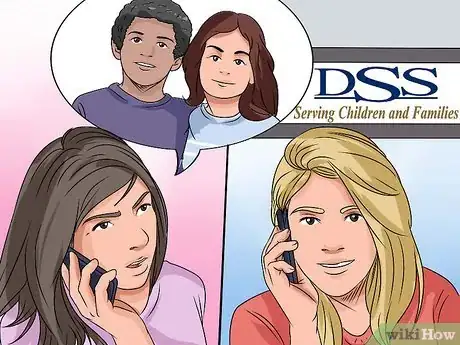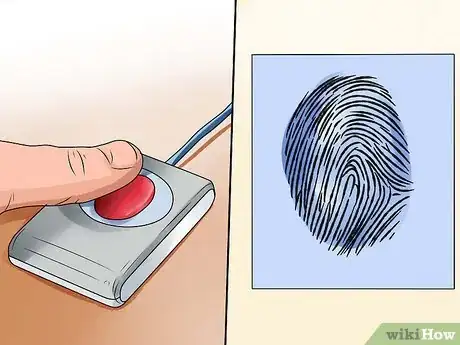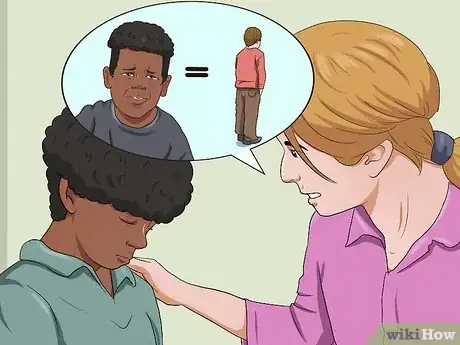This article was co-authored by Clinton M. Sandvick, JD, PhD. Clinton M. Sandvick worked as a civil litigator in California for over 7 years. He received his JD from the University of Wisconsin-Madison in 1998 and his PhD in American History from the University of Oregon in 2013.
There are 10 references cited in this article, which can be found at the bottom of the page.
wikiHow marks an article as reader-approved once it receives enough positive feedback. In this case, 91% of readers who voted found the article helpful, earning it our reader-approved status.
This article has been viewed 60,153 times.
A foster parent is someone who cares for a child when the state has removed that child from his or her natural family because of safety concerns or because the natural family is unable to care for the child. Being a foster parent can be both challenging and rewarding for the foster family and the child being fostered. You can complete the steps to becoming a foster parent in six to eight months.[1]
Steps
Deciding to Become a Foster Parent
-
1Learn how foster parenting works. Foster parenting in the U.S. began with social agencies and was soon endorsed and regulated by state governments in the latter half of the 19th century.[2] Today, the Florida Department of Children and Families oversees 18 affiliated community foster care organizations. You can find a map of the affiliated organizations by county here. Community organizations recruit prospective foster parents, provide training, place children in foster homes, and provide support and manage the cases of children who have been placed.[3]
- In Florida, a foster parent must apply to adopt his or her foster child once the child becomes eligible for adoption.[4]
-
2Understand your responsibilities as a foster parent. A foster parent provides care and a home for children who cannot live with their natural parents or family, either because the family is unable to provide care or because the state has removed the child because of abuse or neglect. The foster parent must also work with health providers, case workers, and a court-appointed legal representative (guardian ad litem). Ultimately, a foster parent provides a stable and nurturing environment with some outside assistance, including training and periodic reviews.
- Foster parents receive a small stipend to help pay for the child's needs, but foster parenting is not otherwise a paid position.
Advertisement -
3Contact your local agency to get started. You can find contact information for each community-based agency here. Contact one of the agencies that serves your geographic area and inform them that you are interested in becoming a foster parent. The agency will guide you through the necessary paperwork and help you to meet the requirements.
- If there is something special about your family that would make your home a good fit for a child with particular needs, discuss that possibility with your agency representative. For example, if your family is able to foster a particular cultural background, or has experience caring for someone with special needs, you may be a good candidate for a certain placement.[5]
Meeting the Requirements
-
1Meet preliminary requirements. The requirements to become a licensed foster parent differ from state to state. In Florida, foster parents must meet the following minimum requirements:
- Be at least 21 years of age;[6]
- Have at least one adult in the home who speaks English;[7]
- Be able to pass a criminal and child abuse background check;
- Be able to safely care for a foster child in your present circumstances; and
- Have enough income to support your family without depending upon a stipend from the foster care system, child support payments, or alimony/spousal support.[8]
-
2Attend an orientation. You will need to attend a free orientation, at which you will receive information on becoming a foster parent and have an opportunity to ask questions.[9] Ask your community agency for upcoming orientation dates and locations.
-
3Complete 20-30 hours of training. Foster parents must complete training classes, including how to deal with attachment issues affecting foster children, manage a child's behavior, maintain connections with the child's birth family, and understand the impact of fostering on the foster family. Parents also receive training in safety precautions, plus CPR and first aid.
-
4Pass a background check. You community agency will perform a background check. The check is intended to uncover any past history of child abuse or criminal activity. You may be disqualified for violent crimes, drug offenses, felony theft, a DUI within the past five years, or if you are currently on probation.[10]
- Other adults in your home and any potential babysitters may be required to pass a background check as well.
-
5Provide references. Your agency may require that you provide references from employers, friends and family, and your children's school or daycare.[11] The agency may wish to contact them directly, or just have them fill out a questionnaire.
-
6Participate in a home inspection. Your community agency will ask to conduct an inspection of your home. Your home must meet certain safety standards, such as having a fire extinguisher and locking up any firearms.[12] [13] There are also occupancy and space requirements. For example:
- There can be no more than five children in a single home;
- There can be no more than two children under two years of age in the home;
- Each child must have his or her own bed;
- Children older than twelve months cannot share a room with the foster parent(s); and
- Children of different sexes over three years of age cannot share a bedroom unless they are siblings and the agency grants permission. [14]
Welcoming Your Foster Child into Your Home
-
1Ask a lot of questions. After you have finished your training and received your first placement, ask you caseworker to answer any questions you have about the child's background. You should also ask for instructions about what you might need to purchase (from clothes to diapers and baby wipes) or any steps you will need to take to enroll the child in school.[15] Also ask:
- Why is the child in foster care?
- Does the child have any learning disabilities or emotional issues?
- Has the child been in foster care before?
- Are the child's medical shots up to date?
- Does the child have any allergies or other medical concerns?
-
2Introduce yourself to the child. Smile, speak in a soft voice, and let your foster child address you with the name that makes him or her comfortable. The child may prefer to call you by your first name instead of "Mom" or "Dad."[16]
-
3Prepare a space for the child. Whether the child has his or her own bedroom or shares it with another, the room must be 40 square feet per child who sleeps in it.[17] Before your foster child arrives, make sure that you have a bed and enough space to store personal belongings. Consider having a nightlight available as well, and encourage the child to display photographs of his or her birth parents and anyone else important to him or her.[18]
-
4Prepare for adjustment difficulties. Your foster child may have particular needs related to emotional, psychological, behavioral, and/or developmental issues. These needs commonly manifest as PTSD, adjustment disorders, anxiety, depression, ADHD, and Oppositional Defiance Disorder.[19] Be prepared to be patient and provide comfort, encouragement, security, and normalcy.[20]
- Mental health resources are usually available to foster children through a social worker or counselor. Ask your caseworker about scheduling counseling and who you can call for assistance in an emergency.
-
5Communicate. Early on, give your foster child a tour of your home and spend some time explaining the rules of the house. Turn this into a conversation by asking the child about his or her expectations in your home. Keep taking time to talk and ask questions to learn more about your new foster child.[21] Open communication promotes a stable and healthy relationship.
Warnings
- This article is intended as legal information and does not provide legal advice. If you need legal advice, contact a licensed attorney.⧼thumbs_response⧽
References
- ↑ http://www.adoptuskids.org/for-families/state-adoption-and-foster-care-information/florida
- ↑ http://nfpaonline.org/page-1105741
- ↑ http://www.familiesfirstnetwork.org/FamiliesFirstNetwork/AboutUs.aspx
- ↑ https://www.childwelfare.gov/pubPDFs/homestudyreqs.pdf
- ↑ http://ocfs.ny.gov/main/fostercare/living.asp
- ↑ https://www.childwelfare.gov/pubPDFs/homestudyreqs.pdf
- ↑ https://www.childwelfare.gov/pubPDFs/homestudyreqs.pdf
- ↑ https://www.childwelfare.gov/pubPDFs/homestudyreqs.pdf
- ↑ http://www.eckerd.org/get-involved/foster/get-started/
- ↑ http://www.familiesfirstnetwork.org/FamiliesFirstNetwork/Orientation.aspx
- ↑ http://www.familiesfirstnetwork.org/FamiliesFirstNetwork/Orientation.aspx
- ↑ http://www.familiesfirstnetwork.org/FamiliesFirstNetwork/Orientation.aspx
- ↑ https://www.childwelfare.gov/pubPDFs/homestudyreqs.pdf
- ↑ http://www.familiesfirstnetwork.org/FamiliesFirstNetwork/Orientation.aspx
- ↑ https://www.fosterclub.com/sites/default/files//Welcoming%20a%20Foster%20Child%20Into%20Your%20Home%20-%20Adoption.NET_.pdf
- ↑ https://www.fosterclub.com/sites/default/files//Welcoming%20a%20Foster%20Child%20Into%20Your%20Home%20-%20Adoption.NET_.pdf
- ↑ https://www.childwelfare.gov/pubPDFs/homestudyreqs.pdf
- ↑ https://www.fosterclub.com/sites/default/files//Welcoming%20a%20Foster%20Child%20Into%20Your%20Home%20-%20Adoption.NET_.pdf
- ↑ http://www.ohelfamily.org/?q=content/understanding-unique-needs-children-foster-care
- ↑ http://www.ohelfamily.org/?q=content/understanding-unique-needs-children-foster-care
- ↑ https://www.fosterclub.com/sites/default/files//Welcoming%20a%20Foster%20Child%20Into%20Your%20Home%20-%20Adoption.NET_.pdf
About This Article
Being a foster parent can be a rewarding way to help a child in need. To become one in Florida, you’ll need to be at least 21 years old, be able to pass a criminal and child abuse background check, and have enough income to support your family without a foster care stipend. If you’re eligible, you can attend a foster care orientation in your area for more information. You’ll likely need to complete 20-30 hours of training, which includes CPR and first aid classes. You’ll also need to pass a background check and provide references that can vouch for you as a safe and responsible parent. Before a child comes to stay with you, a community agent will inspect your home to make sure it passes safety standards. To learn how to make your foster child feel welcome in your home, read on!












-Step-14.webp)




























































